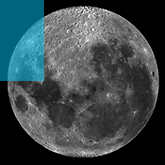 |
CHAMÄLEON + ONJALA OBSERVATORY – LUNAR
ATLAS Segment 02 |
back to OVERVIEW HOME CHAMÄLEON |
|

|
|||
| Moon age 3.3 days - Illumination 12.3 %
NEW 2016 Lunar Domes Condorset und Dubiago NEW 2016 Lunar Domes Vendelinus NEW 2016 FF-Crater Humboldt and Dome Petavius Pe 1,lava flows |
Moon age 4.5 days -
Illumination 17.1 % Lunar dome Petavius and pyroclastic deposits inside of crater Humboldt Lunar dome Messier and pyroclastic areas in Mare Fecunditatis |
Moon age 5.1 + 5.5 days - Illumination 21 - 25 %
Lunar dome Messier Pyroclastic areas in Mare Fecunditatis |
| Moon age 16.3 days -
Illumination 99.2 % (waning
moon) NEW 2016 Dome Petavius, lava flows |
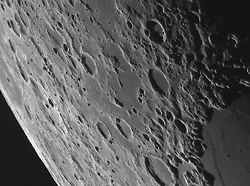 |
NEW 2016 Condorset and
Dubiago The Condorset domes (marked with 1 to 4 ) and Dubiago 3 are typical effusive domes similar to Yerkes 1. They are located in Mare Undarum and have a diameter between 8 and 12 km and heights between 110 and 270 meters. They are all approximately orientated in radial direction to the Crisium Basin and therefore its origin can be associated with the Crisium impact. The Condorset dome are very difficult to image. This image was taken at a lunar age of only 3.3 days with 12.3 % illumination. In addition, there must be optimal libration conditions like in our image where the maximum libration was fortunately at Mare Crisium (see also the crater Napier). To get an optimal 3D impression the domes should be imaged at a lunar age of about 2.6 days. |
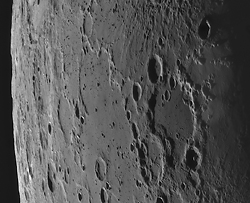 |
NEW 2016 Vendelinus The origin of the Vendelinus domes Ve 1 and Ve 2 is likely not intrusive. Ve 1 has a diameter of about 16 km at a height of 80 meters, Ve 2 a diameter of 13 km and a height of just 30 meters. Southwest are three dome-like structures, marked with a, b and c. The Vendelinus dome are also very difficult to image because they are located on the western crater wall from Vendelinus and they are extremely flat. The image was taken at a moon age of only 3.3 days with 12.3 % illumination. In addition, the libration must be optimal. In our image the maximum libration was at Mare Crisium. |
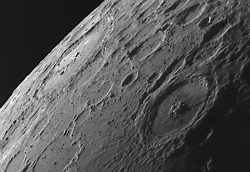 |
NEW 2016 Petavius Pe 1 and Humboldt Petavius Pe 1 In the southern part of Petavius (172 km) there is one of the few domes within a crater. Pe 1 is an effusive dome with a diameter of about 20 km and a height of 240 meters with a large summit caldera (and addtional three smaller ones) with a diameter of about 3 km. The dome itself is not visible on our image from 07.07.2016 because the to the sunlight was too steep. It is visible in our image at waning moon phase At the southeastern edge of the crater floor is a fissure surrounded by pyroclastic ash deposits. |
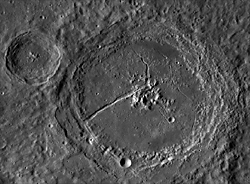 |
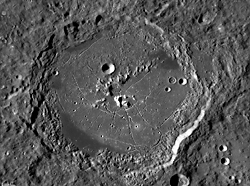 |
<< LRO images of Petavius and < Humboldt with a resolution of 250 m/px in
equidistant cylindrical projection. Both are great craters. Unfortunately, Humboldt can not be seen from Earth like in this LRO image. |
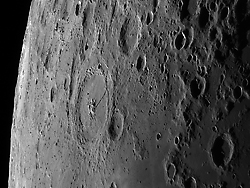 |
Petavius Pe 1
With this illumination, all 4 summit craters of the dome are visible (at the southern edge of Petavius). At the northern crater wall, the cleft with the pyroclastic ash deposits is visible. The large crater Humboldt is very close to the edge when the libration conditions are not so good. Nevertheless, one of the large dark lava flows is visible. |
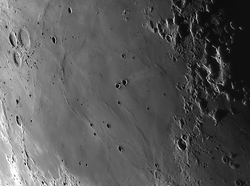 |
Messier Me 1 and Me 2 in Mare
Fecunditatis Two small effusive domes Me 1 and Me 2 with diameters of 7.5 and 7.7 km are located near the craters Messier and Messier A are. Their heights are 80 and 85 meters. Both seem unspectacular. The craters Messier and Messier A with its comet-like ray system are the real "eyes" of the region. They probably arised from a triple impact at a very shallow incidence angle from eastern directions. |
 |
Putative Domes and a Plateau in Mare Fecunditatis If you look at the image more closely, there seems to be many more small effusive domes and even larger volcanic structures in Mare Fecunditatis. They are marked with circles in th elarge image. From two of the structures - A and B - we also show LRO images. A is a "pancake"-like flat structure and B is a fracture system with pyroclastic deposits. Both images have a resolution of 125 m/px and show the surface in equidistant cylindrical projection. LRO image with structure A and the craters Messier and Messier A LRO image with structure B |
 |
Domes and Pyroclastic deposits in Mare Fecunditatis -
Moon age 5.1 days (21
%) Only a hint of the effusive domes are visible at this lunar phase. For this, the pyroclastic ash deposits become more distinct. Also, the ray system of Messier and Messier A is more apparent in contrast. A closer look at the image shows a few small, short crater chains. |
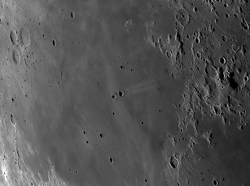 |
Pyroclastic deposits in Mare
Fecunditatis - Moon age
5.5 days (25 %) With a further increase in illumination the ray system and the pyroclastic deposits are even more apparent. |
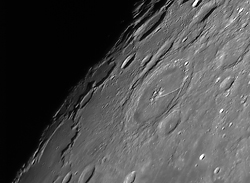 |
NEW 2016 Petavius Pe
1 Petavius at waning moon. With this illumination the two pyroclastic deposits are very clearly visible. At the north crater wall ( marked with 1 ) the deposits of a fissure eruption and at the southern crater wall ( marked with 2 ) the deposits of the lunar domes. The dome itself and the largest of the four summit openings are also visible. |
| top of page |
 |
 |
 |
 |
 |
 |
 |
 |
 |
 |
 |
 |
| Segm. 01 | Segm. 02 | Segm. 03 | Segm. 04 | Segm. 05 | Segm. 06 | Segm. 07 | Segm. 08 | Segm. 09 | Segm. 10 | Segm. 11 | Segm. 12 |